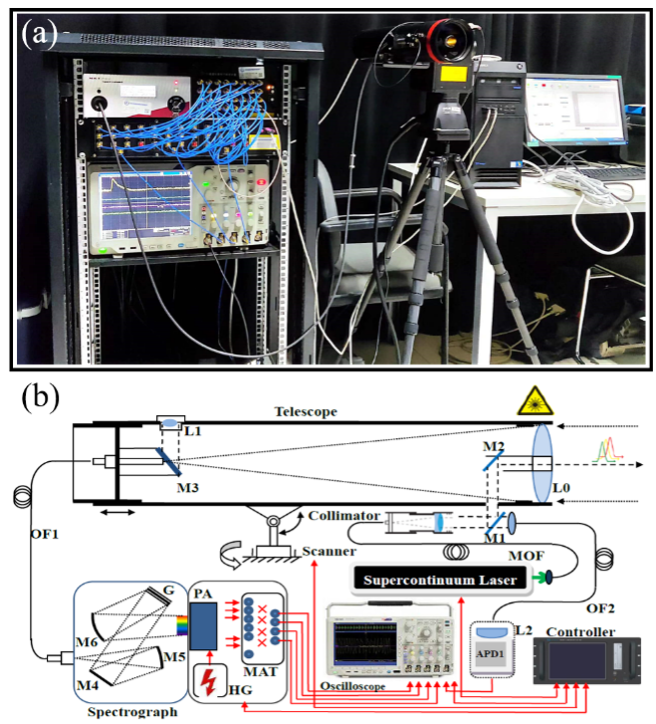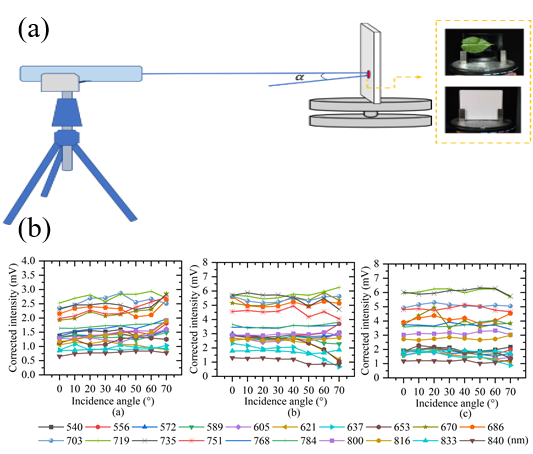Research Reveals Generation Mechanism of Radiative Effects on Novel Active Optical Hyperspectral LiDAR System
May 15, 2023
As both the geometric and spectral information of the target are available with the hyperspectral light detection and ranging (LiDAR) in a single measurement, this advanced technique extends the scope of imaging spectroscopy into spectral three-dimensional (3D) sensing. However, two major geometric radiative effects exist in hyperspectral LiDAR, namely, the distance effect and incidence angle effect, which seriously restrict its quantitative remote sensing applications.
A research team led by Prof. NIU Zheng from the State Key Laboratory of Remote Sensing Science with the Aerospace Information Research Institute (AIR), Chinese Academy of Sciences (CAS) proposed correction algorithms while studying the geometric radiative effects existing in hyperspectral LiDAR.
The team discovered that the analysis and correction of the distance effect and incidence angle effect can be carried out independently. They proposed a piecewise function model that couples a quadratic function and an exponential decay function to analyze and correct distance effect and developed an improved Poullain algorithm to analyze and correct the incidence angle effect.
The results were published in ISPRS Journal of Photogrammetry and Remote Sensing and IEEE Transactions on Geoscience and Remote Sensing.
They found that distance effect originates from the system itself, and all wavelengths have a unified distance effect function. Based on this, they proposed a piecewise function model that couples a quadratic function and an exponential decay function to analyze and correct distance effect.
For different types of vegetation leaf targets, they usually exhibit different incidence angle effects due to their different surface microscopic physical structures and internal biochemical parameters. This effect is closely related to the bidirectional reflection characteristics of the measured target species under hyperspectral LiDAR conditions.
Therefore, the team pointed out that the more accurate expression of incidence angle effect of hyperspectral LiDAR should be "the incidence angle effect of a certain target under hyperspectral LiDAR". They developed a new improved Poullain algorithm to correct the incidence angle effect of the target.
Compared with the traditional Lambert cosine law based on the assumption of isotropic scattering and the original Poullain algorithm, this algorithm considers the heterogeneity of the target roughness factor and diffuse reflection coefficient under different incidence angles and wavelengths, which is more in line with the reflection characteristics of natural target echoes.
The results of different vegetation leaf experiments showed that the standard deviations of the correction results were reduced by 30% to 60%, compared with the echo intensity and reflectivity under the standard 0-degree incidence angle.
The algorithm provides an important theoretical basis and technical support for accurate inversion of three-dimensional biochemical parameters of vegetation in the future.
Currently, the laboratory has completed the design and development of the second-generation hyperspectral LiDAR system with high-speed acquisition capability, which is undergoing performance testing and is expected to be put into use by the end of 2023.
As early as 2014, the laboratory designed and developed the world’s first 32-band hyperspectral LiDAR system with independent intellectual property rights. Since then, the laboratory continued to conduct research on this new sensor in hyperspectral LiDAR system design and development, data acquisition and processing, radiative information extraction and inversion, and other related fields.
The research is supported by the Key Project of National Natural Science Foundation of China " Radiative Transfer Mechanism and Retrieval of Vertical Distribution of Plant Biophysical and Biochemical Parameters ".

The photograph of the first-generation of hyperspectral LiDAR and the optical schematic diagram. (Image by AIR)

The distance experiment principle depiction of the hyperspectral LiDAR. (Image by AIR)

The principle of the incidence angle effect experiment and corrected samples. (Image by AIR)
Contact: luyq@aircas.ac.cn



News & Events